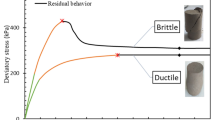Abstract
This paper presents the results of geotechnical and mineralogical investigations on lime treated clay soils from Hamedan City, Iran, and effects of pH variations on their shear strength parameters. Initially, lime was added in different percentages and laboratory experiments were conducted after curing times. The results indicate that these soils can be stabilized satisfactorily with the addition of about 7 % lime. Also, investigation of the relationship between lime-treated geotechnical properties and lime percentage and curing time demonstrates high regression coefficients for the proposed relationships. Several laboratory tests were performed on treated and untreated clay soils with lime mixed with pore fluids with different pH values including 3, 5, 7 and 9. The results of shear strength tests indicated that the undrained shear strength parameters for untreated clays increased considerably if the pore fluid had a high pH (pH = 9) or a low pH (pH = 3). It can also be found that for lime-treated soils, maximum cohesion and friction angle values are achieved at pH = 9.













Similar content being viewed by others
References
Al Rawas AA, Goosen MFA (2006) Expansive soils-Recent advances in characterization and treatment. Taylor & Francis group, Balkema
American Society for Testing and Materials D2166 (2000) Standard test method for unconfined compressive strength of cohesive soil. Annual Books of ASTM Standards
American Society for Testing and Materials D422 (1990) Standard test methods for particle size analysis of soils. Annual Books of ASTM Standards
American Society for Testing and Materials D6528-00 (2000) Standard Test Method for Consolidated Undrained Direct Simple Shear Testing of Cohesive Soils, Annual book of ASTM Standards, Volume 04.08. Easton, MD
American Society for Testing and Materials D698 (2000) Standard test method for laboratory compaction characteristic. Annual Books of ASTM Standards
Basha EA, Hashim R, Mahmud HB, Muntohar AS (2005) Stabilization of residual soil with rice husk ash and cement. Consruct Build Mater 19:448–453
Basma AA, Tuncer ER (1991) Effect of lime on volume change and compressibility of expansive clays. Transp Resear Board, Washington DC, TRR No. 1296:54–61
Bell FG (1993) Engineering treatment of soils. Chapman and Hall, London
Bell FG (1996) Lime stabilization of clay minerals and soils. Eng Geol 42:223–237
Brady PV, Walther JV (1989) Controls on silicate dissolution rates in neutral and basic pH solutions at 25_C. Geochim Cosmochim Acta 53:2823–2830
Brandenburg U, Lagaly G (1988) Rheological properties of sodium montmorillonite dispersions. Appl Clay Sci 3:263–279
Broderick G, Daniel D (1990) Stabilizing compacted clay against chemical attack. J Geotech Eng ASCE 116(10):1549–1567
Croft JB (1967) The influence of soil mineralogical composition on cement stabilization. Geotechnique 17:119–135
Furukawa Y, Fujita T, Hirayama K (1994) Influence of acid rain on stabilized decomposed granite soil. Proc JSSMFE 34(3):123–135 (in Japanese)
Gajo A, Maines M (2007) Mechanical effects of aqueous solutions in organic acids and bases on natural active clay. Geotechnique 57(8):687–699
Gay G, Schad H (2000) Influence of cement and lime additives on the compaction properties and shear parameters of fine grained soils. Otto Graf J 11:19–31
George KP (1976) Stabilization of sand by asphalt emulsion. TRR. Transp Res Rec 593:51–56
Gori U (1994) The pH influence on the index properties of clays. Bull Int Assoc Eng Geo 50:37–42
Gratchev IB, Sassa K (2009) Cyclic behavior of fine-grained soils at different pH values. J Geotech Geoenviron Eng ASCE 135(2):271–279
Hossain KMA, Lachemi M, Easa S (2007) Stabilized soils for construction applications incorporating natural resources of Papua New Guinea. Resour Conserv Recycl 51:711–731
Jasmund K, Lagaly G (1993) Tonmineral und Tone. Steinkopff Verlag, Darmstadt
Kamon M, Ying C, Katsumi T (1996) Effect of acid rain on lime and cement stabilized soils. Jap Geotech Soc 36(4):91–96
Kassim KA, Chern KK (2004) Lime stabilized malaysian cohesive soils. J Kejuruteraan Awam 16:13–23
Mohamed AS, Mohamed AS, Yaser MM (2009) Utilization of lime for stabilizing soft clay soil of high organic content. Geotech Geolo Eng 27:105–113
Okumura T, Terashi M (1975) Deep lime mixing method of stabilization for marine clays. 5th Asian regional conference of soil mechanics and foundation engineering, pp 69–75
Ola SA (1977) The potentials of lime stabilization of lateritic soils. Eng Geol 11:305–317
Pierce JW, Siegel FR (1969) Quantification in clay mineral studies of sediments and sedimentary rock. J Sediment Petrol 9:187–193
Rahman AMD (1986) The potentials of some stabilizers for the use of lateritic soil in construction. Build Environ 21:57–61
Rogers CDF, Glendinning S, Roff TEJ (1997) Modification of clay soils for construction expediency. Geotechn Eng 125:1–8
Sabry MA (1977) Mineralogical and engineering properties of compacted soil lime mixture. PhD thesis, Oklahama State University, Oklahama
Santamarina JC, Klein KA, Palomino A, Guimaraes MS (2002) Microscale aspects of chemical-mechanical coupling: interparticle forces and fabric. In: Di Maio, Hueckel, Loret (eds) Chemomechanical coupling in clays; from nanoscale to engineering applications. pp 47–63
Sherwood PT (1993) Soil stabilization with cement and lime: state-of the-art review. Her Majesty’s Stationery Office, Transport Research Laboratory, London
Sridharan A, Prakash K (1999) Mechanism controlling the undrained shear strength behaviour of clays. Can Geotech J 36(6):1030–1038
Wang YH, Siu WK (2006) Structure characteristics and mechanical properties of kaolinite soils I. Surface charges and structural characterizations. Can Geotech J 43(6):587–600
White RE (1997) Principles and practice of soil science. Blackwell, Oxford
Wieland E, Stumm W (1992) Dissolution kinetics of kaolinite in acidic solutions at 25 °C. Geochim Cosmochim Acta 56:3339–3355
Author information
Authors and Affiliations
Corresponding author
Rights and permissions
About this article
Cite this article
Ghobadi, M.H., Abdilor, Y. & Babazadeh, R. Stabilization of clay soils using lime and effect of pH variations on shear strength parameters. Bull Eng Geol Environ 73, 611–619 (2014). https://doi.org/10.1007/s10064-013-0563-7
Received:
Accepted:
Published:
Issue Date:
DOI: https://doi.org/10.1007/s10064-013-0563-7




